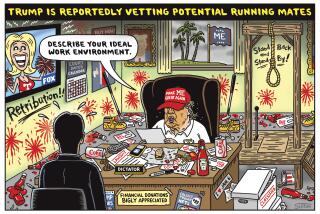A political cartoonist reveals his secrets in a new video
Political cartoons have infuriated kings, crooks and captains of industry since the days of the penny press in 19th century England. In a new video produced by two talented Los Angeles Times staffers, Armand Emamdjomeh and Don Kelsen, I describe how I carry on this satirical tradition in a world of iPads and online news. Please check it out.
One thing I may not have stressed enough in the video is the work that comes before dreaming up ideas and doing drawings. I learned about that early from one of the masters, Paul Conrad. From 1964 to 1993, Conrad was a formidable editorial voice at this newspaper. His cartoons won Pulitzer Prizes in three different decades. I was lucky enough to meet Conrad when I was just starting my career, and I asked him how I could be a better cartoonist. His answer was simple: “Read, read, read.”
And he was right. It’s not just about drawing. It’s not just about humor. It’s about knowing enough to intelligently engage in the great debates of our times. It is a privilege to have a job where I can jump into that debate, and it’s an honor to practice my craft in the place where Conrad once raised political art to a lofty standard.
For close to two centuries, cartoonists such as Conrad ruled the world of political satire -- or were, at least, the most lauded court jesters. Now, in the star-power glare of comic commentators such as Jon Stewart and Stephen Colbert, plain old political cartoons can seem old-fashioned.
Still, I think the best cartoons retain a unique, subversive capacity to get inside people’s heads and speak truth to power. Traditionally a creature of print, political cartoons are now finding a new life and new relevance in the world of digital journalism. Cartoons are visual and succinct -- key attributes in grabbing the attention of wide-roaming online readers.
Excuse me now, it’s time to do the hard work. I need to go read, read, read.
More to Read
A cure for the common opinion
Get thought-provoking perspectives with our weekly newsletter.
You may occasionally receive promotional content from the Los Angeles Times.







